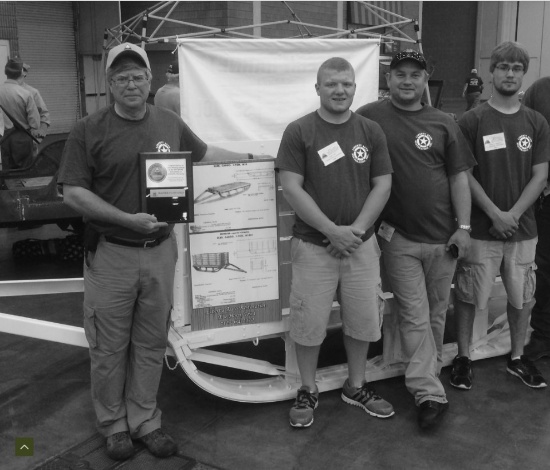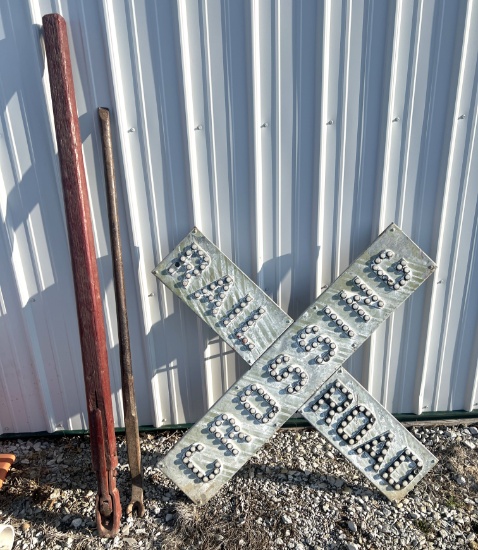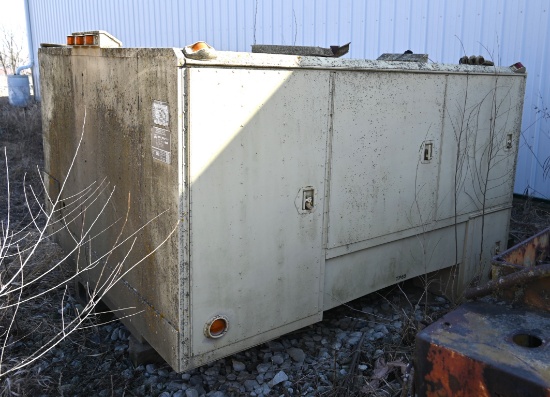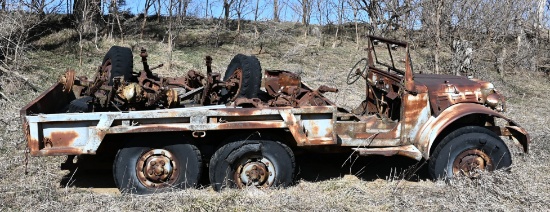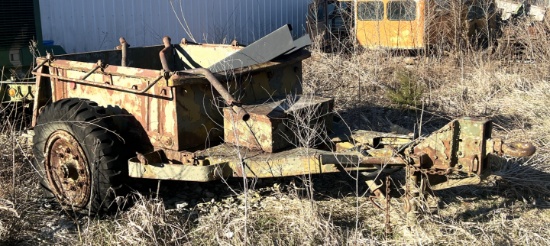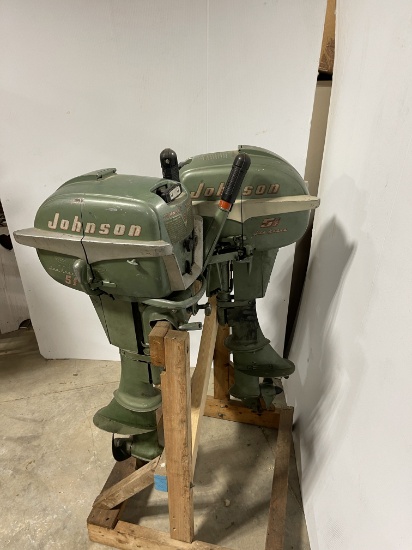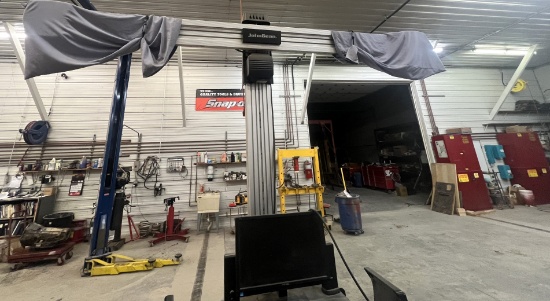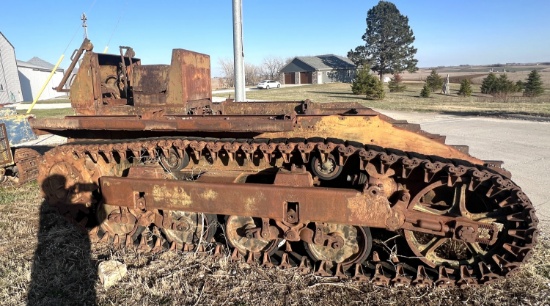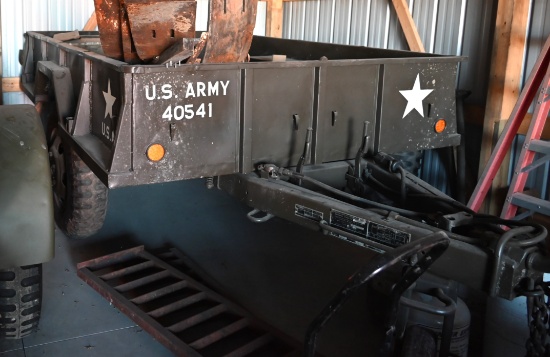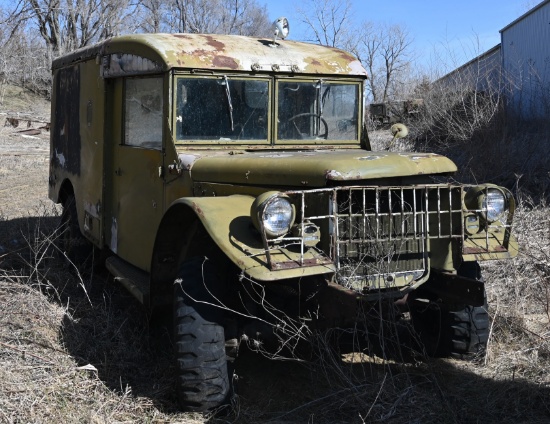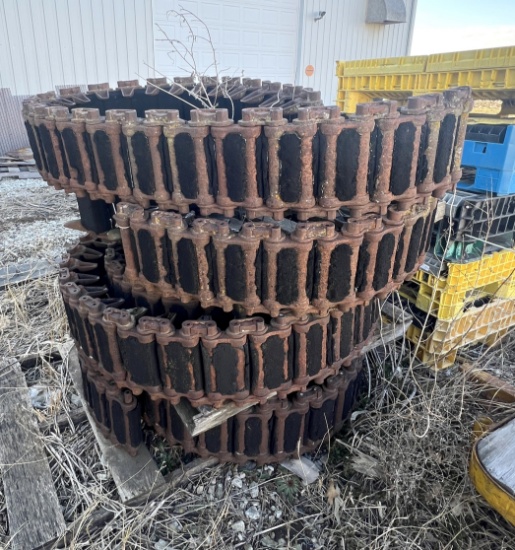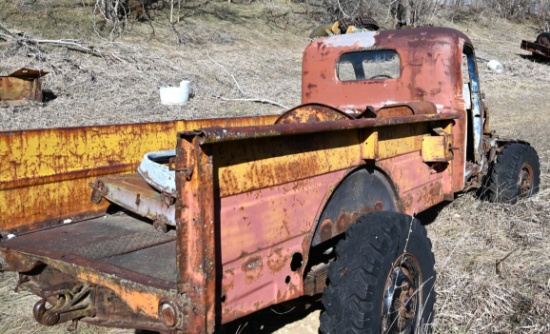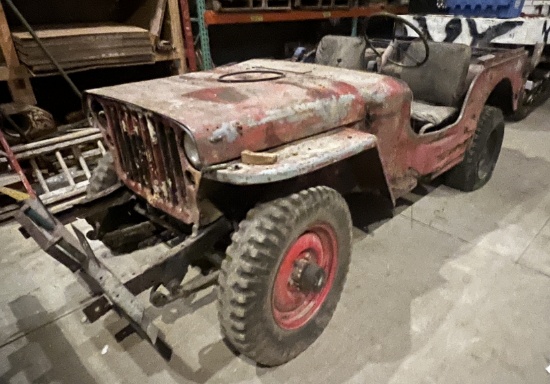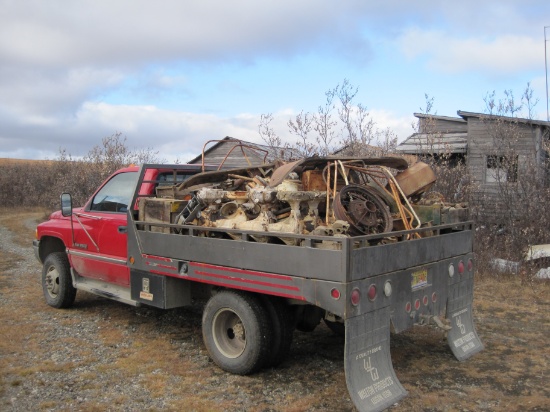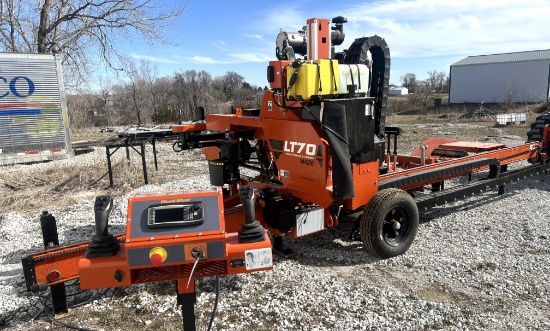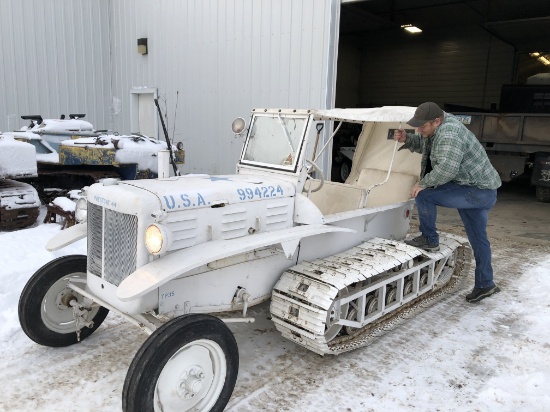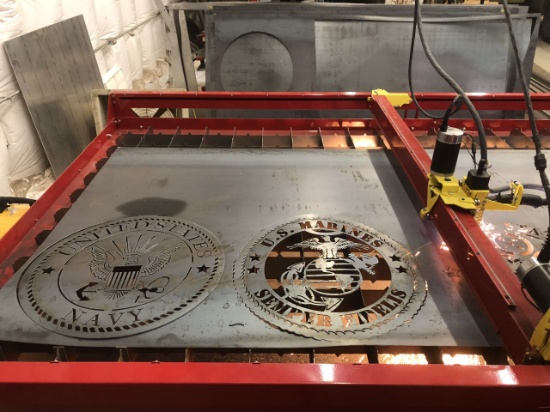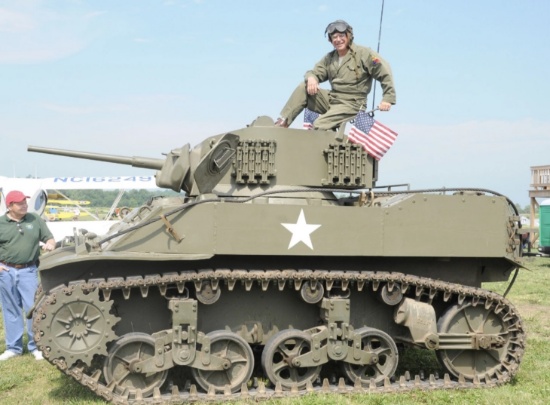
LAR Restorations Retirement Auction
LAR Restorations Retirement Auction
Description
Railroad Crossing Sign & Railroad Track Tools
This lot includes a RR crossing sign and tools that were used on the Atlantic Northern Railroad that ran from Harlan IA through Kimballton and Elk Horn, IA
Antique Lunkenheimer Brass Bronze Train Steam Engine Steam Whistle 13”
The Lunkenheimer Brass Bronze Train Steam Engine Steam Whistle is a classic and iconic piece of equipment that evokes the golden age of steam locomotives. Crafted from high-quality brass and bronze materials, this steam whistle is renowned for its durability, reliability, and distinctive sound.
With its polished brass exterior and intricate design, the Lunkenheimer whistle is not only a functional device but also a beautiful work of art. Its robust construction ensures longevity even under the harshest operating conditions, making it a favorite among train enthusiasts and collectors alike.
When activated, the Lunkenheimer whistle emits a powerful and resonant tone that can be heard from a considerable distance. Its distinct sound has become synonymous with the romanticism of train travel, evoking images of bygone eras when steam locomotives ruled the railways.
Whether mounted on a vintage steam engine or displayed as a decorative piece, the Lunkenheimer Brass Bronze Train Steam Engine Steam Whistle captures the essence of a bygone era and serves as a testament to the craftsmanship and ingenuity of the past.
Sioux Tools Model 645L Valve Face Grinding Machine
The Sioux Tools 645L Valve Face Grinding Machine is a precision-engineered tool designed for automotive and industrial use, specifically for grinding valves. Crafted with meticulous attention to detail, it embodies Sioux Tools' commitment to quality and reliability.
This machine features a robust construction, utilizing durable materials to ensure longevity and consistent performance in demanding environments. Its sturdy frame provides stability during operation, reducing vibrations and ensuring precise grinding results.
Equipped with a powerful motor, the Sioux 645L delivers ample grinding power to tackle even the toughest valve surfaces with ease. The motor is engineered for efficiency, minimizing energy consumption while maximizing output, making it suitable for prolonged use without compromising performance.
The grinding wheel of the Sioux 645L is meticulously crafted to provide optimal cutting performance and longevity. Its precise design enables it to grind valves to exact specifications, ensuring proper seating and sealing for optimal engine performance.
User-friendly controls make operation intuitive and straightforward, allowing operators to adjust grinding parameters with ease. The machine is designed with safety in mind, featuring protective guards and mechanisms to prevent accidents and ensure operator well-being.
Additionally, the Sioux 645L Valve Face Grinding Machine is designed for versatility, accommodating a wide range of valve sizes and shapes. This adaptability makes it a valuable tool for automotive workshops, engine rebuilding facilities, and industrial settings where precision valve grinding is essential.
Overall, the Sioux Tools 645L Valve Face Grinding Machine stands as a testament to Sioux Tools' dedication to quality, precision, and reliability, making it an indispensable tool for professionals in the automotive and industrial sectors.
Comes with Cabinet and full set of attachments. Unit is in Good Working Condition.
Adams Leaning Wheel Grader No. 21
The Adams Leaning Wheel Grader Model No. 21 was a piece of heavy equipment used for road construction and maintenance, particularly for grading and leveling tasks.
Below are the specifications for the Adams Leaning Wheel Grader Model No. 21:
Manufacturer: Adams Manufacturing Company
Model: No. 21 Leaning Wheel Grader
Production Years: The exact production years can vary depending on the specific model and production runs.
However, Adams Manufacturing Company produced various models of leaning wheel graders from the early to mid-20th century.
Designation: Leaning Wheel Grade
The Leaning Wheel Grader operated by using a blade or moldboard attached to the rear of the vehicle to cut and redistribute soil, gravel, or other materials to level or shape roads and surfaces. Leaning wheel graders typically featured a leaning mechanism that allowed the operator to tilt the grader's wheels to adjust the blade's angle for more precise grading. The leaning mechanism provided greater flexibility and control, especially when working on uneven or sloped terrain.
Manual controls for operating the leaning mechanism, adjusting the blade angle, and controlling vehicle movement. Levers or steering wheels were commonly used for control.
Dimensions:
Length: Varies depending on the specific model and configuration.
Width: Varies depending on the blade width and tire placement.
Height: Varies depending on the overall design and configuration.
Usage:
Used primarily for road construction and maintenance, including grading, leveling, and shaping surfaces.
Also used in construction projects, agriculture, and other industries requiring earthmoving equipment.
Service History:
Leaning wheel graders like the Adams No. 21 were widely used throughout the mid-20th century in various countries for road and infrastructure projects.
They played a significant role in improving transportation networks and infrastructure development.
Legacy:
The Adams Leaning Wheel Grader No. 21 and similar models are considered historic pieces of heavy equipment, reflecting advancements in road construction and maintenance technology.
Some surviving examples may be preserved in museums or private collections, showcasing their historical significance in the development of modern infrastructure.
1990 AG-10 Mainteance Truck Mounted Unit
Could be placed on a truck bed or trailer and run using PTO drive.
The AG-10 Maintenance Truck Mounted Unit, also known as the AG-10 service truck, is a specialized vehicle designed for maintenance and service tasks in various industries such as construction, utilities, telecommunications, and municipal services. Here are the typical specifications for a 1990 AG-10 Maintenance Truck Mounted Unit:
Chassis:
Manufacturer: Various manufacturers could provide the chassis, such as Ford, Chevrolet, Dodge, or International.
Model Year: 1990
Gross Vehicle Weight Rating (GVWR): Depending on the chassis used, typically ranged from 10,000 lbs to 26,000 lbs (4,536 kg to 11,793 kg).
Service Body:
Material: Typically constructed of steel or aluminum for durability.
Configuration: Customized compartments and storage areas for tools, equipment, and materials.
Dimensions: Vary depending on the specific requirements and chassis size.
Mounted Equipment:
Hydraulic Crane: Typically equipped with a hydraulic crane for lifting heavy objects and equipment.
Air Compressor: Integrated air compressor for pneumatic tools and equipment.
Welder/Generator: Onboard welder/generator for welding and powering electrical tools.
Storage: Additional compartments and racks for storing hoses, cables, and other accessories.
Power Source:
Customization: The truck can be customized to meet specific customer requirements and industry standards.
Usage:
Maintenance and Service: Used for maintenance, repair, and service tasks in various industries, including construction, utilities, telecommunications, and municipal services.
Versatility: Suitable for tasks such as lifting, welding, power generation, and pneumatic tool operation.
Service History:
Manufactured in 1990 for various industries requiring mobile maintenance and service capabilities.
Used in commercial, industrial, and municipal sectors for routine maintenance and emergency repairs.
Legacy:
AG-10 Maintenance Truck Mounted Units are recognized for their versatility and utility in various industries. Some units may still be in service today, while others may have been retired or replaced with newer models.
David Bradley Tractors with attachments
Quantity: 2
This lot includes 2 David Bradley Tractors with the implements shown. A spare engine is included along with a spare hood cover. Both units were working 2 years ago when last used. Have been stored inside.
David Bradley tractors were small, versatile farm tractors produced by the David Bradley Manufacturing Co., a division of Sears, Roebuck and Co., from the late 1940s to the early 1960s. These tractors were primarily designed for small-scale farming and gardening tasks.
Here are general specifications for David Bradley tractors:
Engine:
Type: Single-cylinder, air-cooled gasoline engine
Displacement: Typically around 1 to 2 horsepower
Power: Varied depending on the specific model and engine configuration
Transmission:
Typically equipped with a gear-driven transmission
Number of speeds varied depending on the model
Forward and reverse gears available
Drive Configuration:
Two-wheel drive (2WD)
Tires:
Small, pneumatic tires suitable for various terrain types
Rear tire size typically ranged from 4.00-12 to 6.00-12 inches
Dimensions:
Overall dimensions varied depending on the specific model and configuration
Generally compact and lightweight for maneuverability in small spaces
Weight:
Lightweight construction compared to larger agricultural tractors
Typically ranged from a few hundred to around a thousand pounds
Fuel Capacity:
Small fuel tank capacity suitable for the engine size and intended use
Typically enough for several hours of continuous operation
Attachments and Implements:
Various attachments and implements available, including plows, cultivators, mowers, and snow blades
Implements were typically designed to be easily attached and detached for versatility in different tasks
Usage:
Intended for small-scale farming, gardening, and lawn maintenance tasks
Suitable for cultivating small plots of land, tilling soil, and mowing grass
Popular among homeowners and hobbyists for lawn and garden care
Service History:
Produced by the David Bradley Manufacturing Co., a division of Sears, Roebuck and Co.
Sold through Sears catalogs and retail stores
Used primarily in North America, especially in suburban and rural areas
Legacy:
David Bradley tractors are now considered collectibles by enthusiasts and collectors of vintage farm equipment
Some surviving examples are preserved and restored by collectors, showcasing the history of small-scale agriculture in the mid-20th
century
WWII Dodge WC62 Project Vehicle
The Dodge WC62 is a 6x6 cargo truck produced by Dodge during World War II.
Here are the specifications for the Dodge WC62:
Manufacturer: Dodge (Chrysler Corporation)
Model: WC62
Production Years: 1942-1945
Classification: 6x6 Cargo Truck
Engine:
Type: Dodge T214 6-cylinder inline gasoline engine
Displacement: Approximately 230 cubic inches (3.8 liters)
Power: Approximately 92 horsepower at 3,200 rpm
Torque: Approximately 180 lb-ft at 1,200 rpm
Transmission:
Manual transmission
Typically equipped with a 4-speed forward and 1-speed reverse gearbox
Drive Configuration:
Six-wheel drive (6x6)
Two-speed transfer case
Suspension:
Front: Independent suspension with coil springs
Rear: Leaf springs on all axles
Brakes:
Hydraulic drum brakes on all six wheels
Hand-operated parking brake
Tires:
Size: 7.50-20 or 9.00-20 (military-spec off-road tires)
Typically mounted on combat rims
Dimensions:
Length: Approximately 19 feet (5.79 meters)
Width: Approximately 7 feet (2.13 meters)
Height: Approximately 7.5 feet (2.29 meters)
Weight:
Gross Vehicle Weight Rating (GVWR): Approximately 12,000 lbs (5,443 kg)
Curb Weight: Approximately 7,300 lbs (3,311 kg)
Payload Capacity: Approximately 4,500 lbs (2,041 kg)
Fuel Capacity:
Typically equipped with one or two fuel tanks
Capacity varies depending on the model and configuration
Maximum Speed:
Approximately 55-60 mph (88-96 km/h) on roads
Range:
Varies depending on terrain and load
Typically around 200-250 miles (320-400 km)
Special Features:
Steel cab and cargo bed construction for durability and protection
Service History:
Used by the United States military during World War II
Deployed in various theaters of war, including Europe and the Pacific
Served as a versatile cargo and personnel transport vehicle
Legacy:
The Dodge WC62 is recognized for its ruggedness, reliability, and off-road capability
Some surviving examples are preserved in museums and private collections, serving as reminders of their wartime service
WWII Ammo Trailer
The M10 ammo trailer, also known as the M10 Ammunition Trailer, was a crucial component of military logistics during World War II, designed to transport ammunition for various artillery pieces and weapons systems.
Here are the specifications for the WWII M10 ammo trailer:
Manufacturer: Various manufacturers produced the M10 ammo trailer, including private contractors and government-owned arsenals.
Type: Ammunition Trailer
Designation: M10
Production Years: 1942-1945
Payload Capacity:
Gross Vehicle Weight Rating (GVWR): Approximately 3,000 lbs (1,361 kg)
Payload Capacity: Approximately 2,500 lbs (1,134 kg) of ammunition and supplies
Dimensions:
Length: Approximately 133 inches (3.38 meters)
Width: Approximately 60 inches (1.52 meters)
Height: Approximately 46 inches (1.17 meters)
Cargo Bed Dimensions: Varies depending on the specific model and configuration, typically around 8 feet long by 4 feet wide (2.44 meters long by 1.22 meters wide)
Weight:
Empty Weight: Approximately 500 lbs (227 kg)
Construction:
Steel frame construction for durability and strength
Suspension:
Leaf spring suspension system for improved load-bearing capacity and stability Equipped with shock absorbers for smoother rides over rough terrain
Tires:
Size: Typically equipped with military-spec off-road tires, such as 7.50-20 or 9.00-20
Mounted on sturdy steel rims for durability and reliability
Brakes:
Surge hydraulic brakes on all wheels for reliable stopping power
Hand-operated parking brake for added stability when parked
Coupling:
Lunette eye coupling for connection to towing vehicle
Equipped with safety chains and hooks for secure attachment
Usage:
Designed to transport various types of ammunition, including artillery shells, mortar rounds, small arms ammunition, and other supplies
Used by infantry units, artillery battalions, and logistical support units during World War II
Service History:
Deployed by Allied forces in theaters of operation worldwide during World War II, including Europe, North Africa, and the Pacific
Played a crucial role in supplying ammunition to frontline units and supporting combat operations
Legacy:
The M10 ammo trailer is recognized for its durability, versatility, and reliability in military logistics during World War II
Antique Johnson Outboard Motors
Quantity: 4
There is an additional unknown outboard motor included.
The 3 Johnson motors were re-worked and were running 1 year ago when put into storage. The unkown unit worked occasionally.
The Johnson Seahorse 5 1/2 is an outboard motor produced by the Johnson Motor Company, which later merged with Evinrude to become OMC (Outboard Marine Corporation).
Here are the specifications for the Johnson Seahorse 5 1/2 outboard motor:
Manufacturer: Johnson Motor Company (later OMC)
Model: Seahorse 5 1/2
Production Years: 1952-1967 (approximately)
Type: Two-stroke, air-cooled outboard motor
Engine: Type: Single-cylinder, two-stroke engine
Displacement: Approximately 5.5 cubic inches (90.2 cc)
Power: Varies depending on the model year and specific configuration, typically around 3-4 horsepower
Fuel Mix: Gasoline mixed with oil at a specific ratio for lubrication (typically 50:1)
Ignition System:
Magneto ignition system for reliable starting
Spark plug for ignition
Fuel System:
Carburetor: Single-carburetor system for fuel-air mixture
Fuel Tank: External fuel tank mounted on the boat, typically with a capacity of a few gallons
Cooling System:
Water-cooled system for engine cooling
Water pump to circulate cooling water
Gear Shift:
Forward, neutral, and reverse gear shifting options
Gear shift lever located on the motor housing or tiller handle
Starting System:
Manual pull-start mechanism
Recoil starter handle for starting the engine
Exhaust System:
Underwater exhaust system to reduce noise and emissions
Steering:
Tiller steering mechanism for controlling the direction of the outboard motor
Steering handle connected to the motor housing
Weight:
Lightweight design for portability and ease of handling
Typically weighs around 40-50 lbs (18-23 kg)
Dimensions:
Compact size for mounting on small boats
Length, width, and height vary depending on the specific model and configuration
Propeller: Three-blade propeller for propulsion
Propeller diameter and pitch vary depending on the specific model and configuration
Service History:
Widely used in small boats, dinghies, and other watercraft for recreational and commercial purposes
Known for reliability, durability, and ease of maintenance
Legacy:
The Johnson Seahorse 5 1/2 outboard motor is considered a classic among vintage outboard motors
Some enthusiasts and collectors still use and maintain these motors for historic boating experiences
Used 1969 Military Generator Set, 30kw 60 Hz
It uses a GM Detroit diesel 3-53 engine and I believe it's a Westinghouse generator end.
Reference Technical Manuals TM5-6115-321-15 and TM 5-6115-345-12.
Owner obtained this generator from the city of Elk Horn, IA and it was used as a backup generator for the city.
Last run in 2002. Sold as is.
Snap On Model EEWA544A Wheel Aligner
The EEW A544A is a model of wheel aligner manufactured by a company called Snap-on Equipment, which specializes in automotive service equipment.
Here are the specifications for the Snap-on EEW A544A wheel aligner:
Manufacturer: Snap-on Equipment
Model: EEW A544A
Type: Wheel Aligner
Alignment Measurement: The EEW A544A wheel aligner is capable of measuring various alignment angles on vehicle wheels, including:
Toe (front and rear)
Camber
Caster
Thrust angle
Steering axis inclination (SAI)
Included angle
Measurement Method: Utilizes advanced imaging technology or laser sensors to measure alignment angles accurately. Vehicle
Compatibility: Designed to perform wheel alignments on a wide range of vehicles, including cars, light trucks, SUVs, and vans.
Accuracy: Provides precise alignment measurements to ensure proper vehicle handling, tire wear, and fuel efficiency.
User Interface: Equipped with a user-friendly interface, including a display screen and control panel, for easy operation and navigation.
Alignment Procedures: Offers step-by-step alignment procedures and instructions for technicians to follow during the alignment process.
Alignment Adjustments: Provides recommendations for alignment adjustments based on measured alignment angles to bring vehicles into proper alignment.
Database: May include a comprehensive vehicle specifications database to access alignment specifications for various vehicle makes and models.
Features: Depending on the model and configuration, the EEW A544A wheel aligner may offer additional features such as:
Wireless communication capabilities
Vehicle lift compatibility
Real-time adjustment tracking
Integrated printouts and reporting
Vehicle diagnostic capabilities
Installation: Can be installed in automotive service facilities, including independent repair shops, dealerships, tire shops, and alignment centers.
Training and Support: Snap-on Equipment typically provides training and technical support for users of their wheel aligners to ensure proper usage and maintenance.
Service History: The EEW A544A wheel aligner has been used by automotive professionals worldwide for performing accurate wheel alignments and ensuring vehicle safety and performance.
Set of 2 WWII M5 High Speed Tractors for Parts/Restoration projects
Quantity: 2
One has set of tracks on it. Also have top cover with machine gun ring.
The M5 High-Speed Tractor was a World War II-era vehicle primarily used for towing artillery pieces and other heavy equipment.
Here are the specifications for the M5 High-Speed Tractor:
Manufacturer: International Harvester Company (IHC)
Model: M5 High-Speed Tractor
Production Years: 1942-1943
Classification: High-Speed Tractor
Engine:
Type: IHC Red Diamond 450 gasoline engine
Configuration: Inline 6-cylinder
Displacement: Approximately 450 cubic inches (7.4 liters)
Power: Approximately 143 horsepower at 2,600 rpm
Torque: Approximately 330 lb-ft at 1,400 rpm
Transmission:
Manual transmission
Typically equipped with a 5-speed forward and 1-speed reverse gearbox
Drive Configuration:
Four-wheel drive (4x4)
Two-speed transfer case for high and low-range gearing
Suspension:
Front: Independent suspension with coil springs
Rear: Leaf springs
Dimensions:
Length: Approximately 222 inches (5.64 meters)v Width: Approximately 92 inches (2.34 meters)
Height: Approximately 102 inches (2.59 meters)
Weight:
Gross Vehicle Weight Rating (GVWR): Approximately 21,000 lbs (9,525 kg)
Curb Weight: Approximately 14,500 lbs (6,577 kg)
Fuel Capacity:
Single fuel tank located under the driver's seat
Capacity varies depending on the model and configuration
Maximum Speed:
Approximately 30 mph (48 km/h) on roads
Varies depending on terrain and load
Range:
Varies depending on terrain and load
Typically around 200-250 miles (320-400 km)
Towing Capacity:
Capable of towing artillery pieces, trailers, and other heavy equipment
Specific towing capacity varies depending on the model and configuration
Service History:
Used by the United States military during World War II
Deployed in various theaters of operation, including Europe and the Pacific
Primarily used for towing artillery pieces, ammunition trailers, and other heavy equipment
Legacy: The M5 High-Speed Tractor played a crucial role in military logistics during World War II
Smithy Lathe Drill Mill CB-1220 XL with table and tools
Ideal machine for residential to light industrial tasks in metal, plastic, woodworking and more. All operations are simple to set up and all deliver good accuracy. Does right-hand, left-hand, inch and metric threading. 12-speed mill/drill head swivels 360°. Adjusts in height to increase working area by 30%. Machine does lathe turning, lathe facing and boring, vertical drilling and horizontal boring. 3/4 HP, 110 Volts.
Overall dimensions: 42 in.L x 20 in.W x 34 in. H. Model CB-1220XL. Ideal machine for residential to light industrial tasks in metal, plastic, woodworking and more.
The Smithy CB-1220 XL is a combination lathe-mill-drill machine designed for small-scale metalworking and machining projects. Here are the specifications for the Smithy CB-1220 XL:
Machine Type: Combination lathe-mill-drill machine.
Swing Over Bed:
Approximately 12 inches (304.8 mm). Indicates the maximum diameter of a workpiece that can be accommodated on the lathe.
Distance Between Centers:
Approximately 20 inches (508 mm).
Represents the maximum length of a workpiece that can be turned on the lathe.
Spindle Bore:
Approximately 0.787 inches (20 mm).
Indicates the diameter of the hole through the spindle, allowing for the passage of a workpiece.
Spindle Speeds:
Variable speed ranges for both lathe and mill operations.
Typically equipped with multiple speed settings to accommodate various machining tasks.
Spindle Taper:
MT3 (Morse Taper No. 3).
Common taper size used for mounting cutting tools and accessories.
Motor Power:
Typically equipped with a single motor to power both lathe and mill operations. Horsepower rating varies depending on the specific model and configuration.
Chuck Size:
Lathe chuck diameter varies, typically between 3-jaw or 4-jaw chuck options.
Cross Slide Travel (X-Axis):
Typically equipped with a cross slide for the lathe operation.
Allows for longitudinal movement of the cutting tool relative to the workpiece.
Compound Slide Travel (Y-Axis):
Allows for angular adjustment of the cutting tool relative to the workpiece.
Mill Table Size:
Varies depending on the specific model and configuration.
Typically equipped with a compact milling table suitable for small-scale milling operations.
Drill Chuck Capacity:
Typically equipped with a drill chuck for drilling operations.
Capacity varies depending on the chuck size.
Overall Dimensions:
Length, width, and height dimensions vary depending on the specific model and configuration.
Designed to be compact and suitable for small workshop environments.
Weight:
Varies depending on the specific model and configuration.
Typically designed to be relatively lightweight for ease of transportation and installation.
Accessories:
May come with various accessories such as cutting tools, chucks, tool posts, and milling attachments.
Additional accessories may be available separately for expanded functionality.
Control System:
Manual control system for operating the lathe and mill functions.
May include digital readouts or other optional features for enhanced precision and convenience.
These specifications provide an overview of the Smithy CB-1220 XL combination lathe-mill-drill machine, highlighting its capabilities for small-scale metalworking and machining tasks.
M105A1 Restored Military Trailer
Here are the specifications for the M105A1 cargo trailer:
Manufacturer: Various manufacturers produced the M105A1, including Fruehauf, Hobbs, and Condec.
Type: Cargo Trailer
Dimensions:
Length: Approximately 135 inches (342.9 cm)
Width: Approximately 85 inches (215.9 cm)
Height: Approximately 39 inches (99.1 cm)
Payload Capacity:
Gross Vehicle Weight Rating (GVWR): Approximately 5,000 lbs (2,268 kg)
Payload Capacity: Approximately 2,200 lbs (998 kg)
Weight:
Empty Weight: Approximately 2,800 lbs (1,270 kg)
Cargo Bed:
Cargo bed dimensions: Approximately 12 feet long by 7 feet wide (3.66 meters long by 2.13 meters wide)
Suspension:
Leaf spring suspension system
Equipped with shock absorbers for improved ride quality
Tires:
Size: 9.00 x 20 (military-spec off-road tires)
Mounted on dual wheels with steel rims
Brakes:
Surge hydraulic brakes on all wheels
Parking brake for added stability when parked
Coupling:
Lunette eye coupling for connection to towing vehicle
Equipped with safety chains and hooks
Construction:
Steel frame construction for durability and strength
Corrugated steel side panels for added rigidity
Lights:
Equipped with military-spec lighting system, including tail lights, brake lights, and turn signals
Blackout lights for nighttime operations
Usage:
Used for transporting various types of cargo, including equipment, supplies, and personnel
Often towed by military trucks such as the M35 series or similar vehicles
Service History:
Introduced in the 1950s and used by the U.S. military for several decades
Deployed in various theaters of operation, including during the Vietnam War and subsequent conflicts.
Continues to see service in some military units and organizations, although it has largely been replaced by newer trailer models
Legacy:
The M105A1 cargo trailer is recognized for its durability, versatility, and reliability in military operations Some units have been surplus and are used in civilian applications such as agriculture, construction, and recreation
Korean Era Dodge M43 AMbulance Vehicle
Quantity: 2
The Dodge M43 Ambulance, produced during the Cold War era, was designed for military medical evacuation purposes.
Here are the specifications for the Dodge M43 Ambulance:
Manufacturer: Dodge (Chrysler Corporation)
Model: M43
Production Years: 1951-1954
Classification: Military Ambulance
Engine:
Type: Dodge T245 6-cylinder inline gasoline engine
Displacement: Approximately 230 cubic inches (3.8 liters)
Power: Approximately 92 horsepower at 3,200 rpm
Torque: Approximately 180 lb-ft at 1,200 rpm
Transmission:
Manual transmission
Typically equipped with a 4-speed forward and 1-speed reverse gearbox
Drive Configuration:
Rear-wheel drive (4x2)
Two-speed transfer case
Suspension:
Front: Independent suspension with coil springs
Rear: Leaf springs
Brakes: Hydraulic drum brakes on all wheels
Hand-operated parking brake
Tires:
Size: 9.00-16 (military-spec off-road tires)
Typically mounted on combat rims
Dimensions:
Length: Approximately 200 inches (5.08 meters)
Width: Approximately 83 inches (2.11 meters)
Height: Approximately 88 inches (2.24 meters)
Weight:
Gross Vehicle Weight Rating (GVWR): Approximately 9,000 lbs (4,082 kg)
Curb Weight: Approximately 6,500 lbs (2,948 kg)
Fuel Capacity:
Typically equipped with one or two fuel tanks
Capacity varies depending on the model and configuration
Maximum Speed:
Approximately 50-55 mph (80-88 km/h) on roads
Range:
Varies depending on terrain and load
Typically around 200-250 miles (320-400 km)
Special Features:
Modified interior for medical equipment and patient transport
Equipped with stretchers, medical supplies, and emergency lighting
Service History:
Used by the United States military and its allies during the Cold War era
Deployed in various theaters of operation, including Europe and Asia
Served as a frontline medical evacuation vehicle for transporting injured personnel
Legacy: The Dodge M43 Ambulance is recognized for its role in military medical operations during the Cold War
WWII Stuart Tank or M5 High Speed Tractor Tank Pads
This lot contains a set of used tank track pads that can used on either a Stuart Tank or M5 High Speed Tractor. The owner has previously milled off old rubber on his Stuart tank track pads and molded new rubber on these. Owner can provide information on how to restore these track pads.
The M5A1 Stuart tank utilized track pads or track shoes as part of its tracked propulsion system. Track pads are essential components that distribute the weight of the vehicle over the tracks, providing traction and preventing excessive wear on the track links. While specifications for specific track pads can vary depending on the manufacturer and model, here are some general specifications for track pads used on the M5A1 Stuart tank:
Material: Track pads were typically made of hardened steel or a durable rubber compound to withstand the rigors of off-road and combat operations.
Dimensions:
Length: The length of the track pad varied depending on the design and manufacturer but typically ranged from approximately 12 to 18 inches (30 to 45 centimeters).
Width: The width of the track pad was typically designed to match the width of the track link and could range from approximately 6 to 8 inches (15 to 20 centimeters).
Thickness: The thickness of the track pad could vary but was typically designed to provide sufficient durability and surface area for traction.
Weight: The weight of individual track pads varied depending on the material and design but could range from approximately 5 to 10 pounds (2 to 4.5 kilograms) each.
Mounting: Track pads were attached to the track links using bolts, pins, or other fastening methods. The exact mounting system could vary depending on the track design and manufacturer specifications.
Surface Pattern: The surface of the track pad often featured a pattern or texture to enhance traction and stability on various terrain types, including mud, snow, and gravel.
Durability: Track pads were designed to withstand the stress and friction of continuous track operation, providing reliable performance over extended periods of use without excessive wear or deformation.
Service Life: The service life of track pads could vary depending on factors such as vehicle weight, terrain conditions, and maintenance practices. Regular inspection and replacement of worn or damaged track pads were essential for maintaining optimal track performance.
Compatibility: Track pads for the M5A1 Stuart tank were specifically designed to be compatible with the tank's track links and suspension system, ensuring proper fit and function.
Late 40/Early 50's Dodge Power Wagon Restoration Project Vehicle
The early Dodge Power Wagon, introduced shortly after World War II, was a rugged and capable off-road vehicle built primarily for military and civilian use in challenging terrain.
Here are the specifications for the early Dodge Power Wagon:
Manufacturer: Dodge (a division of Chrysler Corporation)
Model Years: The early Dodge Power Wagon was produced from the late 1940s to the early 1950s, with various updates and improvements over time.
Designation: The early Dodge Power Wagon was based on the WC series of military trucks used during World War II.
These trucks were often referred to simply as "Power Wagons."
Engine:
Type: Inline 6-cylinder gasoline engine
Displacement: Approximately 230 cubic inches (3.8 liters)
Power: Approximately 94 horsepower
Transmission:
Manual transmission
Typically equipped with a 4-speed gearbox (though some early models may have had 3-speed transmissions)
Drive Configuration:
Four-wheel drive (4x4)
Two-speed transfer case for high and low-range gearing
Suspension:
Front: Solid front axle with leaf spring suspension
Rear: Solid rear axle with leaf spring suspension
Brakes:
Hydraulic drum brakes on all four wheels
Hand-operated parking brake
Tires:
Typically fitted with military-spec off-road tires
Size varied, but common sizes were 9.00-16 or 8.25-16
Dimensions:
Length: Approximately 178 inches (4.52 meters)
Width: Approximately 79 inches (2.00 meters)
Height: Approximately 79 inches (2.00 meters)
Weight:
Gross Vehicle Weight Rating (GVWR) varied depending on the specific model and configuration, but typically ranged from 6,000 to 7,500 lbs (2,722 to 3,402 kg)
Fuel Capacity:
Typically equipped with a single fuel tank with a capacity of around 20-30 gallons (75-114 liters)
Maximum Speed:
Approximately 50-55 mph (80-88 km/h) on roads
Range:
Varies depending on terrain and load, but typically around 200-250 miles (320-400 km) on a full tank of fuel
Cargo Capacity:
The Dodge Power Wagon was available in various body styles, including pickup truck, chassis cab, and utility truck configurations, with varying cargo capacities
Usage:
The early Dodge Power Wagon was used for a wide range of applications, including military transport, agriculture, forestry, construction, and utility work
Legacy:
The Dodge Power Wagon earned a reputation for ruggedness, durability, and off-road capability, establishing itself as an iconic American truck brand
It laid the foundation for subsequent generations of Dodge Power Wagons and influenced the development of modern heavy-duty trucks
1945 Ford GPW Jeep, 4/45 sn 109596
Specifications for the WWII Ford GPW:
Manufacturer: Ford Motor Company (under license from Willys-Overland Motors)
Weight: Approximately 2,453 lbs (1,113 kg)
Length: Approximately 131 inches (333 cm)
Width: Approximately 62 inches (158 cm)
Height: Approximately 49 inches (125 cm)
Engine:
4-cylinder, inline, liquid-cooled engine
Displacement: 134.2 cubic inches (2.2 liters)
Power output: Approximately 60 horsepower at 4,000 rpm
Transmission:
3-speed manual transmission
2-speed transfer case
Speed:
Maximum speed: Approximately 65 mph (105 km/h) on road
Cruising speed: Typically around 45 mph (72 km/h)
Range: Approximately 285 miles (459 km) on a full tank
Fuel Capacity: 15 US gallons (57 liters)
Crew: Typically operated by a driver and one passenger
Tires:
Size: 6.00 x 16 inches
Four-wheel drive with low-pressure tires for off-road traction
Suspension:
Front: Solid axle with leaf springs
Rear: Solid axle with leaf springs
Brakes: Hydraulic drum brakes on all four wheels
Steering:
Worm and roller steering mechanism
Turning radius: Approximately 18 feet (5.5 meters)
Ground Clearance: Approximately 9.25 inches (23.5 cm)
Payload Capacity: Approximately 800 lbs (363 kg)
Production:
Produced from 1941 to 1945
Total production: Over 280,000 units (combined with Willys MB)
Service History:
Widely used by Allied forces during World War II
Served as a versatile utility vehicle for transportation, reconnaissance, and various other roles
Legacy:
Recognized as one of the most iconic military vehicles of World War II
Valued for its reliability, durability, and off-road capabilities
Continues to be celebrated by enthusiasts and collectors worldwide for its historical significance and rugged design.
The WWII Ford GPW Jeep, an enduring symbol of Allied military ingenuity and versatility, remains an iconic representation of the World War II era. Born out of the necessity for a rugged, multi-purpose vehicle capable of traversing diverse terrains, the Ford GPW Jeep epitomized simplicity, durability, and reliability on the battlefield.
With its distinctive silhouette and utilitarian design, the Ford GPW Jeep was a true workhorse, serving a myriad of roles ranging from reconnaissance and personnel transport to cargo hauling and ambulance duty. Powered by a robust 4-cylinder engine, delivering approximately 60 horsepower, it boasted remarkable agility and off-road capability, navigating rough terrain with ease.
Measuring approximately 131 inches in length, 62 inches in width, and 49 inches in height, the Ford GPW Jeep featured a compact yet functional layout. Its open-air design provided unparalleled visibility and accessibility, while its lightweight construction facilitated rapid deployment and maneuverability in combat situations.
Equipped with a 3-speed manual transmission and 2-speed transfer case, the Ford GPW Jeep could achieve speeds of up to 65 mph on roads, ensuring swift movement between frontlines and rear areas. Its four-wheel-drive system, coupled with low-pressure tires, offered exceptional traction on various surfaces, from muddy trails to sandy deserts.
The Ford GPW Jeep's versatility extended beyond its mobility, as it could be easily adapted to accommodate different mission requirements. Its modular design allowed for the installation of specialized equipment, such as mounted weapons, radio communication systems, or field ambulance kits, enhancing its effectiveness in diverse operational scenarios.
Throughout World War II, the Ford GPW Jeep played a pivotal role in Allied military campaigns, serving alongside soldiers in every theater of war. Its reliability, durability, and adaptability earned the trust and admiration of troops and commanders alike, cementing its legacy as a quintessential symbol of Allied victory.
Decades after its wartime service, the Ford GPW Jeep continues to captivate enthusiasts and collectors worldwide, with its timeless design and historical significance. As a testament to human ingenuity and resilience in the face of adversity, it remains a cherished symbol of courage, camaraderie, and sacrifice during one of the defining periods of the 20th century.
WWII M7 Allis Chalmers Snow Tractor Parts
Proxibid only allows 5000 characters and we have more parts than what we can list here in the description due to this 5000 char limit.
Adapter, Speedometer Drive
Arm, Arm Assy.
Arm, Aux. Trans. Shift Assembly
Arm, Spindle L. H. Assy, Arm, Spindle R. H. Assy.
Aux Trans Shifter
Axle Assembly, Front,Axle, Rear Idler Wheel
Blade Windshield
Bolt, Adjusting Track Release
Bolt, Battery Hold down
Bolt, Bell Crank Support
Bolt, Nut Battery Terminal
Bolt, Rear Wheel Track Release Arm
Bolt, Steering Tube Universal Joint
Boogie Short Shaft Assembly
Bow, Top, Canopy
Brace, Radiator Mounting
Bracket Rear Floor Support
Bracket RH
Bracket, Pivot, Assembly ( Right And Left Have Same Part Number )
Brake Drums
Brake Rod Assy.
Bumper
Bushing, Final Drive Axle Carrier
Bushing, Spindle Arm
Bushing, Track Roller Supp. Hub
Cable, Battery Ground
Cable, Battery To Starter Solenoid
Cap, Aux. Trans. R. Brg. Ret.
Cap, Final Drive Axle Shaft End Bearing
Cap, Radiator
Carrier, Final Dr Axle BRG Inner
Carrier, Final Drive Axle Brg Outer
Chain, Track Drive
Clamp, Support To Frame, Assembly
Cleat, Rope
Collar, Front Axle Pivot Pin
Compass
Connector, Left Hand, Side And End Board
Connector, Right Hand, Side And End Board
Cover Final Drive Housing
Cover, Manifold Heater Assembly
Covering, Clamp Assy.
Cranking Motor Support
Curtain, Front Left Hand
Curtain, Front Right Hand
Curtain, Side
Differential And Housing Assy.
Door, Blackout Tail And Stop
Drive Chain Half Link
Electric Brake Coupling Socket
End, Tie Rod
Fork Shifter
Frame, Battery Hold Down
Frame, Sub Assembly
Frame: Left
Front Hub
Fuel Gauge
Fuel Line
Fuel Sending Unit
Fuel Tanks
Gasket Aux Trans. R Brg Retg Cap
Gasket Aux. Trans. Cover
Gasket Diff Cover
Gasket Pipe To Manifold
Gasket Trans Case
Gasket, Fuel Gauge Sending Unit
Gasket, Muffler To Manifold
Gauge Water Temperature
Gear Box
Gear, Aux. Trans. Drive
Gear, Aux. Trans. Sliding
Gear, Speedometer Drive
Gear, Speedometer Driven
Generator Mounting Bolts
Hand Crank
Harness, Black Out Switch To Tail Lamp
Harness, Blackout Switch To Stop Light
Harness, Dist. To Sending Unit Wiring
Harness, Reg. To Gen. Wiring
Harness, Switch To Headlight Junction
Heater Engine Pre Assy.
Housing, Tail And Stop Light
Hub Track Drive Sprocket
Hub Track Supporting R0ller Assembly
Hub, Boogie Wheel Assy
Hub, Track Supp. Roller Assy.
Instrument Panel
Intake Manifold
Knob
Lamp, L. H. Head, Assem.
Lamp, R. H. Head, Assem.
Lens, Spotlight
Lever Shifter
Lever, Aux, Trans. Shift
Lever, Brake
Lever, Wiper Blade
Light Dash Assem.
Light dash Assy.
Line Fuel Primer Nozzle To Nozzle
Link, Clutch
Link, Clutch Control Lever
Linkage, Clutch
Lock, Aux. Trans. Drive Shaft Nut
Lock,Track Release Adj. Bolt Nut
Muffler
Nut, Aux. Trans. Drive Shaft
Nut, Aux. Trans. Driven Shaft
Nut, Track Release Bolt
Oil Pressure Gauge Sending Unit
Packing, Aux. Trans. Driven Shaft
Pad, Clutch Pedal
Pin Transmission Support
Pin, Pivot Assembly
Pintle Hook Assembly
Plate Assembly, Right Hand Upper
Plate, Adjusting
Plate, Adjusting
Primer Pump Parts
Primer, Fuel
Quadrant, Upper
Radiator Fan
Reflector
Release Spring Bolt
Rest, Front Assembly
Ring, Brake Drum Snap Fig# 11-2j
Ring, Final Dr. Outer Brg. Carrier Snap
Screw, Cap, Chain drive Sprocket To Hub
Seal, Aux. Trans. Shift Arm
Seal, Oil
Seal, Wheel Brg Oil
Set Screw, Rear Idler
Shaft, Aux. Trans. Driven
Shaft, Aux. Trans. Shifter
Shaft, Bogie Wheel Long
Shaft, Bogie Wheel Short
2007 F-750 Super Dty 60ft Bucket Truck
Engine: Caterpillar C-7, SN KAL51526
Automatic Transmission
11ft 2in height clearance
Altec Boom Assembly (60ft)
200 Gallon Diesel Tank
On Board Air Compressor
24 Volt system
Boom has Hoist System
Boom can be controlled from within the Bucket or at Base of Boom. Originally purchased from B&K Ventures in Knoxville, IA in 2017. Truck has been stored inside since and has been regularly serviced by a certified ASE Mechanic.
Mileage is 121,430 milesHobbs hours is 746.8 hours
Owner used truck to service Ham Radio Towers at 60ft.
Wood Mizer LT70 Wide Sawmill, like new with extra blades
The Wood-Mizer LT70 Wide is a professional-grade sawmill designed for large-scale wood processing operations.
Here are the specifications for the Wood-Mizer LT70 Wide Sawmill:
Manufacturer: Wood-Mizer
Model: LT70 Wide
Type: Stationary band sawmill
Log Capacity:
Maximum Log Diameter: 36 inches (91 cm)
Maximum Log Length: Typically up to 20 feet (6.1 meters) or longer with extensions
Cutting Capacity:
Maximum Board Thickness: Typically up to 16 inches (40.6 cm)
Maximum Board Width: Typically up to 34 inches (86.4 cm)
Engine:
diesel
Horsepower: 55 horsepower
Blade Length:
Typically equipped with a 158-inch (401 cm) saw blade.
The saw blade can be easily replaced for different cutting applications.
Blade Speed:
Variable blade speed options for optimal cutting performance.
Blade speed typically ranges from approximately 3000 to 4000 feet per minute (914 to 1219 meters per minute).
Hydraulic System:
Hydraulic log handling system for loading, turning, and clamping logs.
Hydraulic blade tensioning for consistent blade performance and longevity.
Hydraulic log clamp and roller system for secure log positioning during cutting.
Control System:
User-friendly control panel for operating the sawmill.
Digital setworks for precise cutting measurements and adjustments.
Optional computerized control systems for advanced functionality.
Features:
Debarker attachment available for removing bark from logs before cutting.
Board return system for efficiently handling finished boards.
Hydraulic log loading arms for easy log handling.
Lubemizer system for blade lubrication and cooling.
Dimensions:
The dimensions of the sawmill can vary depending on specific configurations and options.
Typically equipped with a sturdy steel frame for stability and durability.
Weight:
The weight of the sawmill varies depending on the model and configuration.
Typically ranges from approximately 4000 to 6000 lbs (1814 to 2722 kg).
Usage:
Designed for professional woodworkers, sawmill operators, and large-scale wood processing operations.
Ideal for sawing a wide range of wood species and dimensions for lumber production, furniture making, and other woodworking applications.
Allis Chalmers M7 Snow Tractor Project Kit
Video link of owners M7 snow tractor in the snow.
M7 Snow Tractor in the Snow link
All the parts are provided for assembling a complete M7 Snow Tractor. Engine has been re-built. New LAR Track bands are provided for the snow tractor grousers.
Owner is available to answer all questions to assemble this unit.
The M7 (T26E4) snow tractor was standardized in August 1943, and was downgraded to Limited standard in November 1944. It was intended to pull a one-ton M19 snow trailer (T48). The tractor used many Allis Chalmers farm tractor components. It also used many Willys MB jeep powertrain components to lessen the military's spare parts inventory requirements.
The distinguishing feature of the M7 was the track system (halftrack). The M7's track ran on two rubber belts with four steel cables inside. The machine had a tendency to have the tracks come off in use. Another feature of both the tractor and trailer is that the tires could be switched with skis.
Prototyping of the machine that eventually became the M7 included several machines by Emmett Tucker (of subsequent Tucker Sno-Cat fame). At least one of the prototypes, a T26E3, still exists.
Something over ten percent of production, over 30 units, still survive. The track system and track plate width (18") look to have been borrowed from the early versions of the Weasel, although the M7 tracks are shorter with fewer plates.
The M7 Allis Chalmers Snow Tractor, a stalwart of winter warfare during World War II, stands as a testament to ingenuity and adaptability in challenging environments. Developed to traverse snow-covered landscapes and icy terrains with ease, this rugged vehicle played a crucial role in supplying and supporting troops in harsh winter conditions.
With its distinctive design and robust construction, the M7 Snow Tractor embodied reliability and durability in the face of extreme weather conditions. Powered by a formidable engine, it effortlessly negotiated deep snowdrifts and icy expanses, ensuring crucial logistical support reached frontline units regardless of the season.
Measuring approximately [insert dimensions], the M7 Snow Tractor boasted a compact yet sturdy frame, allowing it to navigate narrow mountain passes and rugged terrain with agility and precision. Its specialized tracks and traction system provided superior grip on snow and ice, enabling it to maintain stability even in the most treacherous environments.
Equipped with a cargo bed or towing capability, the M7 Snow Tractor served a multitude of purposes on the battlefield. Whether transporting supplies, towing artillery pieces, or evacuating wounded soldiers, it proved to be a versatile and indispensable asset for Allied forces operating in snow-bound regions.
Despite the harsh conditions of winter warfare, the M7 Snow Tractor showcased remarkable reliability and performance, earning the respect and admiration of soldiers who relied on its capabilities to accomplish their missions. Its enduring legacy as a vital component of cold-weather operations continues to be celebrated by historians and enthusiasts alike, underscoring its significance in the annals of military history.
As a symbol of resilience and resourcefulness in the face of adversity, the M7 Allis Chalmers Snow Tractor remains an iconic representation of the ingenuity and determination of those who served on the snowy battlefields of World War II.
Plasma Cam 700 Cutter System 5 x 10 ft cutting table
The PlasmaCAM 700 is a CNC plasma cutting system produced by PlasmaCAM, a renowned manufacturer of such machinery. Here are the specifications for the PlasmaCAM 700:
Cutting Capacity:
Typically capable of cutting various types of metal, including steel, stainless steel, aluminum, copper, and other conductive metals. Cutting thickness can vary based on the power of the plasma cutter used with the system. It can typically cut mild steel up to 1 inch thick or more, depending on the plasma cutter's specifications.
Table Size:
The table size of the PlasmaCAM 700 is approximately 5 x 10 feet. This size provides ample space for cutting a wide range of metal sheet sizes.
Cutting Speed:
The cutting speed varies based on factors such as material thickness, desired cut quality, and power of the plasma cutter. Generally, CNC plasma cutting systems like the PlasmaCAM 700 offer relatively high cutting speeds compared to other cutting methods.
Accuracy:
The PlasmaCAM 700 offers high precision and repeatability, allowing for intricate and accurate cuts. The system's design and construction contribute to maintaining precise cuts over extended periods of use.
Software:
The PlasmaCAM 700 comes with PlasmaCAM's proprietary CAD/CAM software. The software allows users to design or import cutting patterns, set cutting parameters, and control the cutting process. It features user-friendly interfaces and tools for designing and editing cut files.
Plasma Cutter Compatibility:
The PlasmaCAM 700 is compatible with various plasma cutters available on the market. Users can choose a plasma cutter based on their specific cutting requirements, such as cutting thickness, speed, and precision.
Control System:
The PlasmaCAM 700 is controlled by a computerized system that interprets cutting instructions from design files. The control system manages the movement of the cutting torch across the metal sheet according to the programmed cut paths.
Ease of Use:
The PlasmaCAM 700 is designed to be user-friendly, with intuitive software interfaces and easy setup procedures. It is suitable for both experienced operators and those new to CNC plasma cutting technology.


 x Cancel
x Cancel